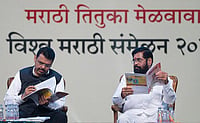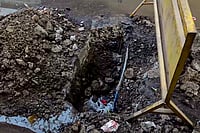One way in which Soviet Russia organised employment for its artisans and craftsmen was to put them to work on building "frontages" of perfect villages. These elaborate stage sets lined the roads where Soviet dignitaries and foreign guests were due to pass by. A cast of "happy peasantry" was assembled, and these fake Olgas and Olyas would wave cheerily at the vips. Behind the frontages lay poverty, deprivation, the grimness of many Siberias.
That's one way to deal with the "eyesore" of poverty and slums, to fake it; there are two others. The options are: fake it, demolish it, or turn it into a tourist spot where the rich can literally go slumming. All three approaches are well-known to the citizens who occupy the reclaimed land in Mumbai known as Dharavi, famous or infamous as "Asia's largest slum". Kalpana Sharma argues that the reason none of them would work is that to see Dharavi simply as a "slum" and to see a "slum" simply as an eyesore that must be tucked out of sight is to tragically oversimplify a complex issue.
Why would the outsider not see Dharavi as one gigantic slum? It has all the right (wrong?) hallmarks. ngos estimate that there are 18,000 people to every square foot in Dharavi. Organisations that have attempted to create a liveable ratio of 15 people to every toilet have had to settle for a ratio of 100 people to one. Not because residents do not want toilets but because the built-up area is too dense to build on—the only free spaces are garbage dumps.
But the reality of Dharavi is far more complex than the stereotypes. It can be argued plausibly that Dharavi is predominantly an industrial area. Aside from the leather and tanning industries it is associated with, Dharavi houses metalworkers, small scale food industries; thanks to the prohibition years, it houses illicit liquor stills; thanks to pollution, it no longer houses fishermen.
The media likes soft-focus stories that dwell on the ‘paradoxes' of Dharavi—pockets of prosperity, the property owners—without realising that this reflects the 80:20 rule: in any mini-city, which is what Dharavi is, 20 per cent of the people will control 80 per cent of the resources. Sharma brings the people of Dharavi alive, from the smuggler who became a chikki magnate to the many who see no shame in having Dharavi for an address. Dharavi is home to many Indian communities, not just one or two. The balance that kept the mosaic intact was disturbed by the riots of 1992-93: due to the machinations of the political elements who have converted the ruination of India into a career, Dharavi now sees a ghettoisation that was absent before.
Other reviewers have complained that Sharma presents few solutions. That falls into the trap of seeing Dharavi only in terms of a problem that is outside the structure inhabited by People Like Us. What Dharavi needs is not more ersatz solutions and Sharma recognises that. It needs practical help: proper housing finance schemes, aid, not sops, from the government, and an acknowledgement that the ones who should have the most say in the workings of Dharavi are the ones who live there.
Slum That Wouldn't Be
An intimate look at Dharavi, mini-city posing as slum

Slum That Wouldn't Be
Slum That Wouldn't Be
Published At:
- Previous Story
 The Politics of Liquidation : Excerpt From Vikas Kumar Jha's ‘Bihar, Criminalisation of Politics’
The Politics of Liquidation : Excerpt From Vikas Kumar Jha's ‘Bihar, Criminalisation of Politics’ - Next Story
MOST POPULAR
WATCH
MORE FROM THE AUTHOR
×





















